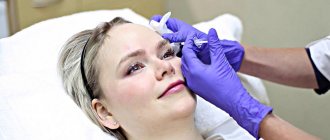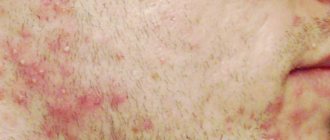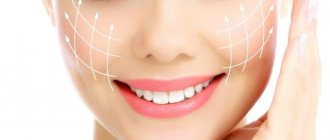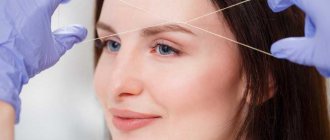Read the article on how to make cheekbones using contouring.
We will also consider the most common questions on this topic: indications, types, at what age can it be done, how long does the effect last, how much does each procedure cost, how to prepare for surgery, what are the contraindications, rehabilitation period, possible complications. It’s rare that a woman is satisfied with everything about her appearance. Looking in the mirror, sometimes it is impossible not to notice something on your face that you would like to correct.
Sometimes decorative cosmetics save the situation, but in some cases only cosmetology can help. Cheekbone plastic surgery can transform a woman’s face, rejuvenate her, and solve the problems of defects and injuries.
General information about cheekbone plastic surgery
In what cases is cheekbone plastic surgery indicated?
- drooping oval face
- fuzzy cheekbones
- disproportionate face
- too sunken or thick cheeks
When deciding on plastic surgery, you should objectively evaluate your external data and be realistic about the result. If the oval of the face is wide, then it will remain that way. More noticeable changes can be achieved with a narrow oval face.
How is cheekbone contouring performed?
A special substance is injected under the skin using thin, blunt-tipped needles called cannulas.
Hyaluronic acid is usually injected because it retains moisture well in the cells.
However, it has a low density and is not inserted deeply. The effect of a procedure with hyaluronic acid is visible for six to eight months and is therefore recommended for those who are under thirty years of age.
If the patient is older, then she is injected with a denser gel based on calcium hydroxyapatite. Thanks to it, the effect will increase by one and a half to two years and will prevent facial asymmetry.
What is lipolifting?
Lipolifting is a procedure that enlarges the cheekbones using injections that contain the patient’s fat tissue.
As a result, as is the case with contour correction, there are no scars and scars, rehabilitation is easy. Fat from the thighs, buttocks and abdomen is used. It is cleansed and injected to increase the volume of the cheekbones and cheeks.
This procedure lasts about an hour. The results last for about three years. The disadvantage of this method is that sometimes the fat cells do not completely take root, so correction needs to be done after some time.
When is surgery necessary?
The surgical method of correcting the cheekbones allows you to solve the problem of asymmetry and significant deformation of the face, overhanging soft tissues. If your cheeks are too big, this can also be solved.
However, it should be taken into account that surgical assistance is provided only after turning 23 years old; by this age the skeletal system is considered to be formed. Also, unlike injections, this method is associated with longer rehabilitation, staying in the hospital for several days.
But the resulting effect lasts ten to fifteen years, provided that all doctor’s instructions are followed.
Wide, low cheekbones don't suit you? This will be corrected by surgery to reduce the cheek bones (reduction malarplasty). 1 day in hospital, 2 months until complete rehabilitation. The result will last a lifetime.
Wide, high cheekbones can be seen on many supermodels - but in real life, those with wide cheekbones are often unhappy with this feature. Why?
The European Cromanoid type with a strong bone structure is characterized by prominent cheekbones, curved at the eye sockets and tapering towards the chin. The upper part of such a zygomatic bone protrudes forward (frontally) from the plane of the face much more than the lower edge. Shaped cheekbones are in demand in the modeling business; they are considered to be a sign of a strong-willed character; in addition, they keep the soft tissues of the cheeks from sagging with age, allowing their owner to maintain the architecture of a youthful face longer.
With the Mongoloid type of face, the cheek bones are also often massive, have a wide and tall body, but lack relief. The zygomatic process of the upper jaw and the zygomatic bone form a single flattened, wide, protruding surface. Protruding wide and flat cheekbones do not create a beautiful, pronounced relief; the face looks massive.
The Renaissance period, when artists and sculptors were interested in mathematics and anatomy, gave us calculations of the ideal proportions of the human body. For the middle third of the face, the ideal width is determined by two ratios:
- the distance between the extreme points of the cheekbones is 4 times greater than the width of the bridge of the nose between the inner corners of the eyes;
- The width of the face between the temples is equal to its width in the region of the mandibular angle and is 10% less than the distance between the edges of the cheekbones.
Previously, owners of large, flat cheekbones could only contour them with a generous layer of decorative cosmetics. Today they offer reduction malarplasty - surgical correction of the width of the face in the cheekbone area. Reducing the cheekbones makes flattened faces more refined, petite and feminine, bringing them closer to classic proportions.
Surgical reduction (reduction) of the cheekbones gives an excellent aesthetic effect on relatively narrow faces, where the area of the cheekbone and zygomatic arch strongly protrudes beyond the boundaries of the ideal oval, while its relief is poorly defined. Since this problem is most typical for the Asian type, South Korea became the pioneer of cheekbone reduction surgery (malarplasty).
Reduction plastic surgery of the cheekbones (Cheek Bone Reduction/Zygoma Reduction) can be performed in three ways:
- cheek bone resurfacing
- osteotomy - excision of a section of the zygomatic bone
- surgical displacement of the zygomatic arch (lateral part of the zygomatic bone and lower part of the temporal bone) inward by dividing into three sections and repositioning
The reduction method is chosen by the surgeon and the patient based on the CT scan data, aesthetic objectives and physiological characteristics of the patient.
Endoscopic malarplasty without repositioning the zygomatic arch is performed under general anesthesia and leaves no marks on the face. It is performed through one incision (in the mouth along the alveolar arch at the level of the incisors) in the case of bone grinding, through three incisions (in the mouth and in the scalp in the area of each temple) in the case of osteosynthesis. The length of the incisions ranges from a few millimeters to 3-5 cm. The risk of damage to the facial nerves during surgery is minimal. In complex cases requiring massive intervention, a combination of malarplasty and endoscopic facelift may be recommended for patients over 30-35 years of age.
The average postoperative hospital stay is 1 day. The active rehabilitation period lasts about 14 days: due to tissue swelling, a compression face mask must be used during this period. As after other operations with intraoral access, after malarplasty there are restrictions on food for some time. Complete facial restoration takes 2-6 months.
In Moscow, malarplasty for aesthetic reasons began relatively recently: unlike South Korean, Singaporean or Chinese surgeons who use standard solutions for pronounced Asian types, Russian specialists work with patients with a mixed type - and for the aesthetic success of the operation an individual approach to each is necessary occasion.
Dr. Guryanov has his own VIP Studio virtual plastic laboratory at his disposal, which allows you to create an individual 3D model based on computed tomography data and three-dimensional light scanning of the face, head and neck. Before malarplasty, the surgeon and the patient plan with high accuracy the desired volume of intervention on a computer model, the system performs calculations, and the result of the operation based on them meets the client’s expectations.
We are making a correction
About the types
The following types of surgical correction exist:
- mandibuloplasty
- removal of Bisha lumps
- endoscopic plastic surgery
- Check-lifting method
Mandibuloplasty
With the help of mandibuloplasty, implants are installed that change the volume and shape of the cheekbones. If the bone is poorly expressed, there is asymmetry, and the cheekbones are drooping, then this type of plastic surgery is used.
Ten days in advance, an examination is carried out and measurements are taken to make individual implants. They are administered under general anesthesia through an incision on the inside of the cheek.
The incision is fixed and the seam is carefully sutured. The operation lasts forty minutes. Rehabilitation lasts six months, but expressive cheekbones remain with you for the rest of your life.
Removing Bisha's lumps
Performed to get rid of excess fatty tissue in the cheek area. This low-traumatic operation corrects the oval of the face. The surgeon makes a small incision in the mouth, then removes excess fat and stitches the wound.
Endoscopy
This method tightens soft tissues and corrects the zygomatic area using special plates. The surgeon makes small incisions in the temple area to insert these plates.
To make the result even better, a gel is also introduced to increase the volume of the cheekbones and correct the oval of the face.
This operation is also considered low-traumatic. Endoscopic equipment is sold here: https://lkmed.ru .
Check-lifting method
It tightens the middle part of the face, eliminates malar edema, and gets rid of a very pronounced nasolacrimal groove. Bruises and bags under the eyes are also a thing of the past. For this purpose, endotins are used, which contain polylactic and hyaluronic acid.
The doctor makes an incision that follows the contour of the ciliary edge of the lower eyelid. The operation takes longer - one and a half to two hours.
How is the rehabilitation going?
The recovery period after surgical correction lasts about six months. The first time after the operation, the woman (or man) must remain in the hospital.
The doctor prescribes antibacterial and painkillers. Applying ice to the face helps relieve pain.
Food at this time should not require chewing. In addition, brushing your teeth will also not be comfortable.
It is recommended to rinse your mouth with an antiseptic. Smoking and alcohol are prohibited.
What complications can there be?
They can be common when bleeding occurs after surgery, scars form, allergies appear, and infection occurs.
Specific complications are also possible when the zygomatic bone is displaced, the face sags, the facial nerve is damaged, oral movements are impaired, and sinusitis appears.
Are there any contraindications?
There are and they should be taken seriously. If you have pathologies of the respiratory organs, there are disturbances in the functioning of the heart, liver, and kidneys. The presence of malignant tumors, poor blood clotting, diabetes, mental disorders, as well as pregnancy are contraindications for correction.
It should be borne in mind that different methods of correction have their own contraindications, which the attending physician warns about.
How to prepare for surgery?
The patient needs to consult with a surgeon and anesthesiologist to take an x-ray and discuss possible results. Sometimes an analysis is prescribed to determine the tolerance of the administered substance. On the eve of the operation, the patient should not drink alcohol, play sports, or smoke.
Rehabilitation
Features, natural temporary ailments and the duration of the rehabilitation period depend on the technique used.
Do you want your rehabilitation to go smoothly? Then I urge you to be as honest as possible with your surgeon: talk about any ailments if you have them, do not hesitate to ask questions, and conscientiously follow all recommendations.
Anesthesia
Endoprosthetics of cheekbones, removal of Bisha's lumps, check-lifting are performed under general anesthesia. Cheekbone contouring and lipofilling can be performed under general or local anesthesia.
Rehabilitation time
After check-lifting and endoprosthetics, rehabilitation lasts several months. Final recovery is approximately 7-12 months. After removing Bisha's lumps, recovery takes a little less time. After lipofilling and cheekbone contouring, rehabilitation lasts on average 3-4 months.
General rehabilitation recommendations for patients
- You cannot play sports in the first months of rehabilitation.
- Any physical activity should be avoided.
- Don't drink alcohol and give up cigarettes.
- Sleeping on your stomach is not allowed until recovery is complete.
- If the manipulations were carried out through incisions in the oral cavity, I will recommend special rinses.
- Do not steam the skin. Solarium, bathhouse, sauna, hot bath are contraindicated during rehabilitation!
- Do not temporarily apply cosmetics to your face.
- Try not to touch the incision area.
- Do not take medications without my consent.
How much will it cost to get beautiful cheekbones?
The cost is determined by what type of plastic surgery is chosen. The price for soft tissue correction and blepharoplasty is about ten thousand rubles. For lipolifting you will have to pay nine thousand rubles.
A more budget-friendly option is contour plastic surgery with hyaluronic acid (four to five thousand rubles), polylactic acid (from nine thousand rubles), calcium hydroxyapatite (from nine thousand rubles).
The surgical method will be more expensive. So, the endoscopic method costs 40-55 thousand rubles, mandibuloplasty costs 60-90 thousand rubles, and Bisha’s lumps can be removed for about thirty thousand rubles.
Today plastic surgery works wonders. What previously upset you about your face will become attractive and attract attention. Aesthetic medicine fulfills the wishes of clients in a short time, pleasantly delighting its clients.











